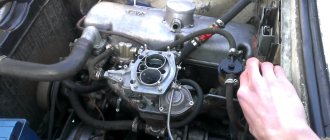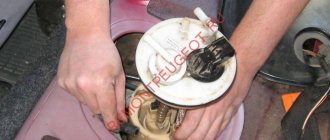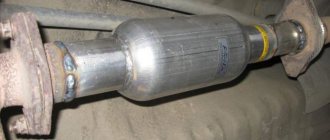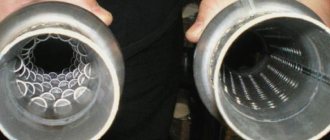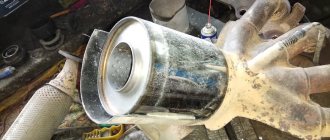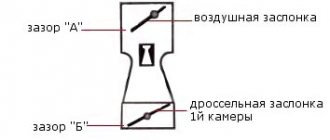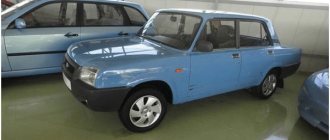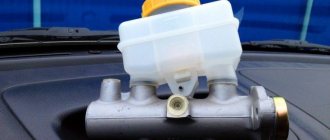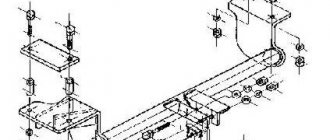When developing most modern cars, technical solutions are widely used in their design, the main task of which is to ensure maximum comfort for the driver and passengers of the vehicle. In addition, a car that comes off the assembly line today simply must be environmentally friendly: it pollutes the air minimally and creates a low level of noise when driving. Environmental standards are especially strict in Europe and the United States, but Russia is gradually moving in the same direction.
Reducing the amount of harmful exhaust into the atmosphere and the noise level of the machine is achieved through the design of the exhaust system and the operation of the catalyst, whose task is to neutralize the main toxic gases generated during engine operation. This is a necessary part of any car; in the West, a car cannot be operated without a catalyst, but in Russia the situation is somewhat different. The fact is that the catalyst is quite expensive (precious metals are used in its design), therefore, after the end of the service life of this element, various cheaper alternatives are sought for it.
One of the most common ways to replace a catalyst is to install a flame arrester in the vehicle's exhaust system. Currently, you can easily find a flame arrester for any type of engine; many well-known foreign and domestic manufacturers of automobile parts are engaged in their production. The most common is the so-called universal flame arrester; they are manufactured by such well-known brands as “Platinik”, “Asmet”, “Ferroz” (Poland), “Asso” (Italy), “Simons” (Finland), “Walker”, “ Universal" (Estonia), "Marmittesara" (Italy).
What is the design of a flame arrester? What are its pros and cons compared to a catalyst? Is it possible to install it yourself or is it better to contact a service station, and what is the optimal size of the flame arrester? What types of flame arresters are there?
Types of flame arresters
- Active, single layer. This type of fire arrestor uses fiberglass or mineral wool core. They are less durable than reactive ones due to the fact that the filler used quickly burns out due to high temperatures. But while it is functioning, it does its job well, for up to 2 years.
- Reactive. The work of such a product is famous for its durability. The basic principle of reducing the energy of gases is based on the damping of sound waves. They can last up to 10 years, depending on the quality of materials, manufacturing and operation.
If we take into account the design features of the exhaust system, flame arresters can also be manifold (which during installation must be removed and installed together with the exhaust manifold) and free-standing.
We will discuss in more detail the characteristics of certain types of flame arresters, the difference in price and the features of their installation in subsequent subtopics.
The principle of operation of the fire arrester
Features of the fire barrier installed on a tank with petroleum products:
- Sparks and flames, passing through channels with a small cross-sectional area, are crushed into small parts. Due to this, the temperature of the gas-air flow decreases sharply.
- During detonation combustion, the narrow channels of the fire arrester crush the shock wave front.
When choosing a fire arrester circuit, specific operating conditions are taken into account. The effect of extinguishing sparks and flames depends mainly not on the length of the channels, but on their cross-sectional area. The narrower the channel, the faster the quenching process occurs. However, if there is a possibility of a large amount of high-temperature combustion products passing through the barrier, then the quenching efficiency begins to be affected by the length of the channels. In this case, a barrier with long channels is required. When hot gases pass through them, they reduce their temperature to a safe limit.
show all
Characteristics of flame arresters
The resonator, also known as a flame arrester, must be temperature stable and withstand heavy mechanical loads, because the speed and temperature of the exhaust generated from the fuel burned in the cylinder are very high, and accordingly they impart their energy to all components involved in the process. The name of the flame arrester speaks for itself. It directly “puts out the flames”, reduces the temperature and converts the exhaust gas streams into one smoother and cooler stream. A good, high-quality flame arrester is designed in two layers, for better absorption of vibrations during the exhaust and to dampen excess noise, and the second layer must be made of anti-corrosion, stainless material, due to the fact that the flame arrester is constantly under the aggressive influence of the atmosphere. Splashes, dirt, salt deposits, a poorly fixed muffler, loads and vibrations from a running engine and when the car is moving, all have a destructive effect on this element and therefore the design and materials must withstand all of the above.
To improve sound insulation, fillers are used: mineral or basalt. In high-quality flame arresters, this factor is also controlled by the introduction of an additional diffuser chamber. The exhaust is pre-processed in this chamber, and then further muffled by hitting the padding layer. The diffuser chamber reduces wear on the flame arrester.
Difference in design
Now we can distinguish several main designs by which flame arresters are made:
- Straight . Essentially, this is a pipe driven into a housing with a certain non-combustible material. That is, here the gases encounter practically no resistance. Often these options are equipped with main “dampers”.
- Funnel . This is when the pipe tapers, that is, the diameter at the top (at the beginning) is larger than the diameter at the bottom (at the end). Here, gas pressure acts on the stacks, releasing some of the gases.
- Spiral type. A spiral is installed inside the pipe, along which the gases seem to descend from the inlet to the outlet.
- Resonator type. Here the device is very similar to a resonator. That is, there are several chambers inside and pipes that are not in one line. Thus, it turns out that gases meet the walls, give up some energy, and only then pass on.
I would also like to note that the wall of any high-quality flame arrester must be double, with a “lining” made of a special non-flammable material. That is, it turns out like a pie, it is done in order to avoid the ringing sound under the bottom of your car.
Flame arrestor and catalyst. Advantages and disadvantages
A flame arrester is a kind of catalyst substitute. Both units have their pros and cons, but if we take into account the efficiency of the engine and the car, the flame arrester outperforms the catalyst on all fronts. The catalyst, due to its design, is a more complex device than a flame arrester; the materials used are rarer, which is very noticeable when you compare the prices of these parts.
The flame arrester costs significantly less and does not delay the exit of exhaust gases as much as the catalyst does. This in turn affects the power supplied by the engine to the drive. Due to certain factors, namely due to poor fuel quality or mixture formation in the combustion chamber of the cylinders, the catalyst tends to quickly fail (clog).
If the catalyst is not replaced in a timely manner, this will adversely affect the engine itself, because the exhaust process will not be carried out fully, and it can also harm people in the cabin, because the exhaust from the inability to find a way out through the muffler will smoke inside the car.
Also, when they want to achieve greater efficiency from the engine, they tune the exhaust system by replacing the catalyst with a flame arrester. This long-lasting exhaust “filter” will equalize the flow and pressure of gases leaving the engine manifold, thereby improving its technical characteristics.
The main disadvantage, which of course can cover up all the advantages of this unit, is that its filtration properties are not as good as those of the catalyst, simply put, they are not there. This means that significant harm is caused to the environment. In the Russian Federation, laws still allow the use of flame arresters as an alternative to catalysts, this is facilitated by established emission standards, but if you want to pull off such a scam in EU countries, you will not pass the scheduled technical inspection of the vehicle and will not be able to use the car.
Types of fire arresters and flame arresters
- fire arrester OP-AA
- fire arrester OP-AAN
- flame arrester PP
- liquid fire fuse
- fire communication fuse POC
Fire arresters OP
Fire barriers OP-AA and OP-AAN protect the gas space of tanks from penetration of sparks or flames. The fire-retardant element located in the housing consists of corrugated and flat tapes that retain heat from the fire and extinguish it. Aluminum is used for their manufacture. The fire arrester OP-AAN is dismountable, which allows the cassette to be inspected and replaced if necessary.
| Fire arrestor OP-AA | Options | OP-50AA | OP-80AA | OP-100AA |
| Nominal size DN | 50 | 80 | 100 | |
| Capacity at air flow resistance 118 Pa, m 3 /h | 25 | 60 | 100 | |
| Height, N, mm | 80 | 80 | 94 | |
| Diameter, D, mm | 140 | 194 | 207 | |
| Diameter of mounting holes | 14 | 18 | 18 | |
| Number of mounting holes | 4 | 4 | 4 | |
| Serviceability retention time, min., not less | 10 | |||
| Weight, kg, no more | 1,3 | 2,62 | 3,6 | |
| Fire arrestor OP-AAN | Options | OP 50AAN | OP 80AAN | OP 100AAN | OP 150AAN | OP 200AAN | OP 250AAN | OP 300AAN | OP 350AAN | OP 500AAN | |
| Nominal size DN | 50 | 80 | 100 | 150 | 200 | 250 | 300 | 350 | 500 | ||
| Capacity at air flow resistance 118 Pa, m 3 /h | 100 | 150 | 200 | 215 | 380 | 600 | 750 | 900 | 2200 | ||
| Height, H, mm | 172 | 200 | 197 | 231 | 255 | 243 | 275 | 419 | 317 | ||
| Diameter, Dн, mm | 160 | 214 | 230 | 303 | 375 | 450 | 530 | 610 | 858 | ||
| Connecting dimensions, mm | D D1 dn, pcs. | 141 110 14 4 | 184 150 17 4 | 205 170 17 4 | 262 225 18 4 | 315 280 18 4 | 370 335 18 6 | 435 395 22 6 | 485 445 22 6 | 644 600 22 16 | |
| Serviceability retention time, min., not less | 10 | ||||||||||
| Weight, kg, no more | 3 | 5 | 6,1 | 10 | 16 | 27 | 30 | 45 | 74 | ||
Flame arrestor PP
PP flame arresters are temporary fire arresters that prevent flames from penetrating into the gas space of tanks. Attached using flanges to mounting pipes; A gasket is installed between the flange and the body, which ensures tightness.
The fire retardant element is made of flat or corrugated tapes and can be made of aluminum or stainless steel. The established service life of PP flame arresters made of aluminum alloys is 5 years, and those made of stainless steel are 10 years.
| Flame arrestor PP | Options | PP-50 AA | PP-100 AA | PP-500 AA |
| Conditional bore (DN), mm | 50 | 100 | 500 | |
| Throughput, m 3 /h | 25 | 100 | 2200 | |
| Length (D), mm | 92 | 148 | 910 | |
| Height (L), mm | 80 | 423 | ||
| Weight, kg | 1,3 | 1,5 | 93 | |
Fire liquid fuses POZH
Liquid fire arresters are used to prevent a possible diesel or gasoline storage tank fire that may occur when gas or vapor is released into the atmosphere. They can be made in cast iron or aluminum housing. The blocking element is made of aluminum tapes, which accumulate the heat of the flame and extinguish it.
Installation is carried out on the receiving pipeline.
| Liquid fire fuse POZH | Options | POZH–80 |
| Conditional diameter, DN | 80 | |
| Pressure, MPa | 0,25 | |
| Throughput at air flow resistance 118 Pa, m³/h | 80 – 100 | |
| Height (H), mm | 94 | |
| Diameter (D), mm | 207 | |
| Diameter of mounting holes | 18 | |
| Number of mounting holes | 4 | |
| Diameter of mounting holes | 170 | |
| Weight, kg | 3,6 | |
| Serviceability retention time, min., not less | 10 | |
| Established service life, years | 8 |
Communication fire fuse POK
Fire fuses POK are installed on oil pipelines to prevent the movement of flame along it. The maximum pressure in the pipeline is up to 1.6 MPa.
Their design is more reinforced, since the movement of the working medium occurs at high speed and at high pressure. Having minimal hydraulic resistance, the liquid flows freely.
The fire retardant element has high heat resistance and fire resistance. As the flame passes through the flame-extinguishing element, the temperature drops below the flash point of the working product. Due to this, extinction occurs.
Fire fuses POK are manufactured in climatic versions U and UHL of placement category 1.
| Communication fire fuse POK | Options | POK-50 | POK-80 | POK-100 | POK-150 | POK-200 | POK-250 | POK-300 | POK-350 | POK-500 | |
| Nominal size DN | 50 | 80 | 100 | 150 | 200 | 250 | 300 | 350 | 500 | ||
| Capacity at air flow resistance 118 Pa, m 3 /h | 25 | 75 | 100 | 215 | 380 | 600 | 300 | 900 | 2950 | ||
| Overall dimensions, mm | D.H. | 215 | 245 | 280 | 335 | 460 | 520 | 600 | 710 | 840 | |
| H | 300 | 303 | 380 | 430 | 490 | 495 | 575 | 737 | 820 | ||
| Connecting dimensions, mm | D | 160 | 195 | 215 | 280 | 335 | 405 | 460 | 520 | 710 | |
| D1 | 125 | 160 | 180 | 240 | 295 | 355 | 410 | 470 | 650 | ||
| d | 18 | 18 | 18 | 22 | 22 | 26 | 30 | 26 | 33 | ||
| n | 4 | 8 | 8 | 8 | 12 | 12 | 12 | 16 | 20 | ||
| Weight, kg, no more | 20 | 28 | 39 | 55 | 113 | 145 | 245 | 290 | 545 | ||
Installation of fire arresters
They are mounted on the roof of vertical tanks under the breathing or safety valve and are attached to the mating flanges using bolts through a gasket. To protect pipelines under pressure up to 1.6 MPa, they are installed in the area where the gas-air mixture may escape.
Installing a flame arrester
If we are talking about replacing the catalyst, then the main reason why they replace it with a flame arrester, and do not weld a simple pipe of the required diameter in the place where this element of the exhaust system is installed, is that when installing a simple pipe, the vibration of the car will increase significantly and the noise during engine operation. Also, the temperature of the exhaust gases will be distributed to other elements of the system, which will lead to rapid wear of its components.
When installing a flame arrester, you must pay attention to the following points:
- How is a used catalyst or flame arrester installed? Is it bolted, clamped, or permanently welded to the pipe? If fastening is done with bolts or clamps, then the gaskets on the flanges must be replaced. If the element is simply welded to the pipe, then it must be cut off and the operation of welding the new part must be entrusted to trusted specialists. It’s better not to do this yourself if you are an amateur welder; experience is needed here.
- The system must be completely sealed and well secured, therefore, after installation work has been completed, it is better to seal the seams and joints with a special sealant.
- Do not tighten the pipe elements too much; this may lead to deformation of the muffler line and squeezing out the gaskets.
- If you install a flame arrester instead of a catalyst, then it is better to install a collector one, which is specifically designed for installation next to the exhaust manifold, where catalysts are usually located.
- You should also pay attention to the car engine. If the cylinder volume exceeds 2 liters, then a universal flame arrester cannot be installed on such a car; either a standard one, specifically for the brand and technical characteristics of this car, or a homemade one will do.
- On cars with a lambda probe (a sensor for measuring the percentage of oxygen in exhaust gases), you need to pay attention to the place where the sensor is installed; if it is installed only in the exhaust manifold, then there will be no problems with it, but if the sensor is installed after the catalyst, after replacement on the flame arrester, it will be necessary to make a modification in the electronic control unit or install a decoy element in front of the sensor.
We have discussed the main points, advantages and disadvantages of this element of the exhaust system. Based on this, each driver himself can make a decision in his own favor and in favor of his pocket, or in favor of the environment and the public. The flame arrester does an excellent job of doing what it is designed to do, but does not have the properties of a catalyst. The choice is yours.
Benefits of replacement
Replacing an expensive catalytic converter with a cheaper flame arrester makes a lot of sense.
The following advantages can be highlighted:
- The cost in the second case is 7-9 times lower, so the savings are obvious here.
- The catalyst reduces the power of the power unit because it creates an obstacle to the passage of exhaust gases, because of this, the “horses” can decrease by up to 7%. On the other hand, when replacing, the exhaust flow encounters virtually no resistance.
- The absence of an expensive filter element makes it possible to use gasoline with a lower octane number, since the more reliable, durable design is resistant to aggressive technical fluids.
- The flame arrester is characterized by strength, reliability, and durability. The possibility of its burning out and the occurrence of corrosion foci is practically eliminated.
Thus, the advantages of replacement are not too many, but they really work. Unstable operation of the power unit can be caused by incorrect settings of the electronic control unit, so it is necessary to make a new electronics setting when replacing devices.
Pros of replacement
Let us highlight a number of advantages that make using the machine more economical, convenient and practical:
- the flame arrester is durable and rarely breaks;
- vehicle operating costs are reduced;
- You can fill the tank with AI-92 gasoline.
Let's look in detail at what causes certain advantages caused by installing a flame arrester. The most interesting mechanism is the mechanism for increasing engine power, or, more precisely, restoring it.
The design of the catalyst makes it difficult for gases to pass through due to the abundance of small honeycombs, which are almost insurmountable. Installing a flame arrester removes resistance previously encountered along the way.
Some experts intimidate inexperienced motorists with engine failure when removing the catalyst. However, this statement is absurd, since with this development of events the load on the motor is reduced.
It must be admitted that a loss of stability of the power unit is likely, but this is due to errors in setting up the ECU firmware. This can be avoided by correcting it taking into account the changed circumstances.
